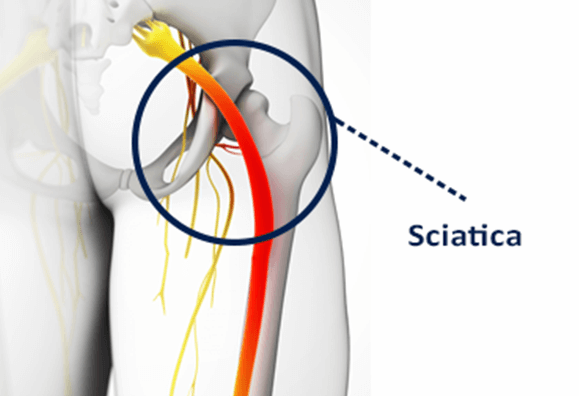Sciatica & Sciatic Nerve Pain
The term “sciatica” refers to the pain experienced when the sciatic nerve becomes compressed (pinched) by spinal abnormalities such as a bulging or herniated disc, degenerative disk disease, bone spurs (osteophytes), scar tissue or inflammation. This nerve is the largest and longest in the body, running from the base of the spine and down through both legs. Pressure on the sciatic nerve can lead to pain that begins in the lower back and moves through the buttocks, legs and feet. This type of pain is referred to as radiculitis, or radiating pain. It is also characterized by other symptoms like muscle cramps, burning, muscle weakness, numbness and tingling.
This condition is very common as it affects a large percentage of people who suffer from spinal conditions or report back pain. The pain radiates down the nerve and affects the lower extremities causing debilitating pain that can ultimately impact your work and personal life, making it difficult to walk or even sleep with sciatica.

Sciatica or Sciatic Nerve Pain
Causes of Sciatica
Lumbar radiculopathy is just the symptom of a medical condition that is compressing or pinching the spinal nerve roots.
Some of the common causes of sciatica include:
- Herniated disc
- Spondylolisthesis
- Bone spurs
- Bulging disc
- Pinched nerve
- Degenerative disc disease
- Lumbar spinal stenosis
A bulging disc or herniated disc is the most common cause of this condition. As the disc bears down on the sensitive nerve (usually affecting the L4/L5 or L5/S1 levels), it restricts blood flow and important nutrients from reaching all sections of the nerve through the lower back, hips, buttocks and down each leg.
When portions of the nerve are deprived of nutrition, they are unable to emit electric impulses in a proper fashion, causing radicular pain along the nerve. When the nerve becomes pinched due to an underlying condition, a number of different symptoms can occur.
Symptoms of Sciatica
Sciatica usually occurs on only one side of the body and follows the nerve from the low back to the foot and toes. In rare cases, patients experience pain on both sides, also known as bilateral lumbar radiculopathy.
Sciatica symptoms include:
- Numbness
- Tingling
- Shooting pains
- Sudden stabbing pains
- A burning sensation
In most cases, the level of discomfort changes with position, but constant, chronic pain is also possible.
Diagnosis
Beginning with a patient history and thorough physical examination, diagnosis may be completed using x-rays or magnetic resonance imaging (MRI). During the physical examination, you may be asked to complete some exercises in order to pinpoint the compressed nerve root.
Exercises for Sciatica
You can find some pain relief from sciatica by doing exercises or stretches. Some exercises include:
- Walking
- Yoga
- Abdominal exercises
- Back extensions
- Leg raises
Specifically, exercise and stretching can help to deal with sciatica in the short term. However, these exercises may only provide temporary relief from the pain. It is also important to speak with your doctor before performing any exercises that could worsen your sciatica pain.
Treatment for Sciatica
A treatment plan usually starts with conservative modalities, such as rest, anti-inflammatory medicine, heat treatment, ice packs, physical therapy, steroid injections and pain management, however in some cases these conservative treatments provide only temporary relief. In these cases surgery may be indicated, the Bonati Spine Procedures can provide immediate relief for sciatica pain, especially if the symptoms of sciatic pain are related to a herniated disc or lumbar bulging disc that is compressing one of the nerve roots before it joins the sciatic nerve. The Bonati Spine Procedures to treat sciatic pain render highly invasive open back surgery unnecessary.
Statistics
- Approximately 5 to 10% of all persons with low back pain have sciatica
- Those ages 45-64 are at the greatest risk of suffering from acute sciatica
- Smoking and mental stress can contribute to pain
- About 90% of sciatica cases are caused by a herniated disc pinching a nerve root
- 20-30% of sciatica suffers have persistent problems after 1-2 years if it is not treated
- Sciatica has been reported in nearly 10% of the population
The Bonati Spine Institute encourages patients suffering from this condition to contact us to request a no-obligation MRI review or discuss your conditions with our medical professionals. Find out why The Bonati Spine Procedures are considered to be among the world’s best solutions when it comes to advanced spine surgery. Your sciatic nerve pain can become a thing of the past.
